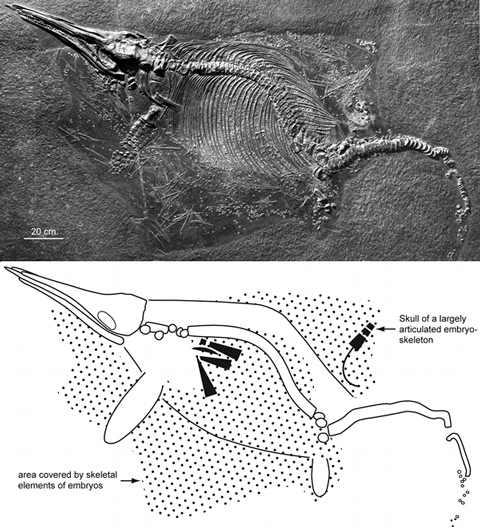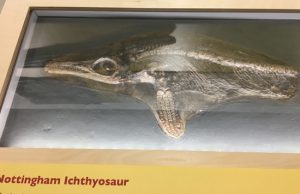Exploding Prehistoric Animal Carcasses as they Rot – New Evidence
Gas Build Up in Rotting Prehistoric Animal Remains did not Cause them to Explode
A new study by scientists from the University of Zurich (Switzerland) has dispelled the theory that putrefaction gases produced by decomposition caused some dinosaur and other prehistoric animal carcasses to explode before they were fossilised.
Prehistoric Animal Carcasses
A number of animals preserved in the fossil record, their subsequent body fossils had puzzled scientists as to how the bones had come to be positioned in relation to other parts of the preserved skeleton or skeletons. In particular, the fossilised remains of a pregnant ichthyosaur (marine reptile) found in the Lower Jurassic deposits of Holzmaden (southern Germany), has intrigued researchers. The skeleton of the adult, is preserved with the majority of the bones in articulation, in the same relative positions as when the animal was swimming around in the Jurassic sea.
Ichthyosaur Embryos
The bones of the ichthyosaur embryos, preserved with this specimen however, are very different. For the most part, they lie scattered outside the body of the mother. Such peculiar bone arrangements are repeatedly found in ichthyosaur skeletons excavated from the finely, grained Holzmaden deposits.
Ichthyosaurs are believed to have evolved the ability to give birth to live young – viviparity. These reptiles did not lay eggs like crocodiles and turtles, but they kept their embryos inside them, until they had reached a certain size before giving birth to independent young.
To read an article on a controversial fossil discovery that suggests that other marine reptiles such as plesiosaurs were also viviparous: Does Plesiosaur Fossil show Evidence of Viviparity?
Holzmaden “Exploded” Ichthyosaur Skeleton
Picture credit: University of Zurich
The picture above shows a photograph of the ichthyosaur fossil and an interpretative line drawing of the fossil showing underneath it. The beautifully preserved adult skeleton is articulated but the fossils of the embryos are scattered over a large area. The scale bar in the photograph represents twenty centimetres.
Embryo Fossils
Most scientists thought that the position of the embryo fossils and their disarticulation was due to the carcase having exploded as gases caused through the process of putrefaction built up in the body cavity. These gases, created as a body decomposes would cause the carcass to swell up and become bloated before finally bursting. It had been thought that through such explosions, even the bones of embryos would have been ejected out of the body. The Zurich based researchers have challenged this hypothesis by carrying out a series of elaborate measurements and an analysis of the physical-biological parameters. The scientific team, which included sedimentologists, palaeontologists and forensic scientists has put forward new evidence that may dispel the myth of exploding prehistoric animal remains.
In order to gauge the pressure of the particular gases that can actually develop inside a putrefying remains of an Ichthyosaurus, the researchers sought comparative models and found one in a surprising area of science – the forensic study of human corpses. Humans and many ichthyosaur are similar in size and as vertebrates we do have roughly the same body plan and digestive tract. As a result, the formation of similar amounts of putrefaction gas can be expected during decomposition of the dead body. At the Institute of Forensic Medicine in Frankfurt, Germany, a manometer (device used to measure pressure) was inserted into the abdominal cavity through the umbilicus in one hundred corpses.
A Beautiful Ichthyosaur Fossil
Picture credit: Everything Dinosaur.
The putrefaction gas pressures measured were only 0.035 bar. In the case of the ichthyosaur remains that came to rest in depths between fifty and one hundred and fifty metres of water, however, putrefaction gas pressures of over five to fifteen bar would have been necessary to cause a body to explode.
Zurich based palaeontologist Christian King, one of the researchers involved in this macabre study believes that gas pressures strong enough to cause a carcase to explode in this depth of water are impossible to achieve.
He stated:
“Large vertebrates that decompose cannot act as natural explosive charges. Our results can be extended to lung-breathing vertebrates in general.”
So what did cause the anomaly of the adult body remaining virtually intact whilst the remains of any embryos associated with the fossil specimen to be scattered?
According to the researchers, the fate of ichthyosaur bodies can be reconstructed, they have theorised as follows:
Normally, the bodies sank to the seabed immediately post mortem. In very deep, hospitable waters, they were broken down completely through putrefaction, scavengers, bone-destroying organisms and dissolving processes, in exactly the same way that marine mammal carcases are broken up today. In shallower water (up to fifty metres in depth) and a temperature of over four degrees Celsius, however, the corpses often rose back to the surface on account of the putrefaction gases accumulating inside the body. As the gases built up, they made the corpse buoyant forcing the body to rise to the water surface, just like a cork when placed in a bucket of water floats to the top. At the surface, exposed to the waves and scavengers, such as fish, pterosaurs and other marine reptiles, the bodies decomposed within anything from a few days to weeks and the bones which were not eaten whole by the likes of a pliosaur were scattered over a wide area on the seabed as they sank.
However, the scientists believe that under very special conditions, ichthyosaur bodies would remain preserved more or less in their anatomical position. A lack of oxygen, medium water depths and insignificant bottom water currents could lead to the fossils that we see today. Because only under these conditions were the putrefaction gases compressed strongly enough through the high water pressure and dissolved in the bodily fluids, and the carcasses not completely broken down due to a lack of scavengers on the seabed. The carcass of the ichthyosaur female from Holzmaden, dated to around 182 million years ago, probably sank to the bottom of the sea, which was up to 150 metres deep, where it decomposed. It was the action of minor underwater currents on the sea floor that carried the decomposing bodies of the embryos out of the mother and scattered their remains around the larger body. The bigger bones of the adult ichthyosaur were less affected by the sea currents and therefore remained in situ.
The Hozmaden deposits have yielded some of the world’s best fossils of marine reptiles, especially plesiosaurs and ichthyosaurs. This new study provides further information on how to interpret fossil vertebrate remains and can help shed light on the potential water depths at which these fossils came to rest.
To read about the discovery of a new species of European ichthyosaur earlier this year: New Ichthyosaur Species Swims into View.
Everything Dinosaur acknowledges the assistance of a press release from the University of Zurich in the compilation of this article.
For models and replicas of marine reptiles including ichthyosaurs: Sea Monsters and Prehistoric Animal Models.



